|
There was then, as there is now, no place
known on earth that even began to compete with these islands in their
capacity to encourage natural life to develop freely and radically up to
its own best potential. More than nine out of ten things that grew
here, grew nowhere else on earth. … Whatever the reason, the fact
remains: In these islands new breeds developed, and they prospered, and
they grew strong, and they multiplied. For these islands were a
crucible of exploration and development.
James A. Michener
Hawaii
The
first experience can never be repeated. The first love, the first
sunrise, the first South Sea island, are memories apart, and touch a
virginity of sense. … Ua-huna appeared upon the starboard bow. Nuka-hiva
was whelmed in cloud. The needles of Ua-pu stood there on the horizon,
in the sparkling brightness
of the morning,
the fit signboard of a world of wonders. …
On our port beam we heard the explosions
of the surf. A few birds flew fishing under the prow. The Casco
skimmed under cliffs, opened out a cove, and began to slide into the bay
of Anaho. The cocoa palm, [“Cocoa palm” –
the earlier name for the coconut palm.] that giraffe of
vegetables, so graceful, … was seen crowding the beach and fringing the
sides of the mountains. The scent of a hundred fruits or flowers flowed
forth to meet us.
We spied a native village standing close
upon a curve of beach, under a grove of palms. The sea in front growled
and whitened on a concave arc of reef. The cocoa tree and the island
man are both lovers and neighbours of the surf. “The coral waxes,
the palm grows, but man departs,” says the sad Tahitian proverb. But
they are, all three, so long as they endure, co-haunters of the beach.
Robert Louis Stevenson In the South Seas
As a seaman myself, and
an avid reader of the accounts of global explorers from Marco Polo, to
Columbus, to Magellan, and on to Scott, Amundsen and Shackleton, I
consider the finest navigator and expedition leader of his time, to have
been James Cook. That remarkable seaman from Marton near Whitby in
Yorkshire, England, was largely self-taught, and joined the British Navy
without any commission or sponsorship, at a time when men had to be
press-ganged into service. He was soon given recognition for his skills
in navigation and charting, and these were put to the test in Canada in
1759, where he plotted the route up the St. Lawrence river for the
British fleet that mounted a successful attack on Quebec under General
Wolfe. He was made marine surveyor of the coast of Newfoundland in
1763, and in the course of those duties published an account of a solar
eclipse that took place in 1766. So it was not surprising that when the
Admiralty needed a competent Captain to lead a scientific expedition to
the uncharted seas of the southern Pacific Ocean, Cook was selected for
the job and given a lieutenant’s commission. He rejected the offer of a
lightly constructed but speedy naval ship for a former Whitby collier
that Cook felt had the strength and seaworthiness necessary for such a
voyage. It was largely due to that decision the Endeavour
survived its grounding on the Great Barrier Reef. The ship was a barque
of 370 tons, carried a crew of 85 persons, and among its distinguished
expedition scientists was the naturalist, Sir Joseph Banks.
Cook’s first Pacific
voyage of 1769 – 1771, took him to Tahiti and the South Pacific, and on
the New Zealand and Australia. During that voyage he charted and named
much of the coast of Australia and New Zealand, and successfully
demonstrated how to prevent scurvy by ensuring that crewmen had a
regular diet of fresh fruit and vegetables. On his return he was
promoted to Commander and put in charge of the HMS Resolution for
a second expedition, this time to explore Antarctic waters, and
additional regions of the South Pacific. Captain Cook was given charge
of a third expedition in the Resolution, to search for a
north-west passage through Arctic waters from the Pacific side, and to
undertake further explorations in that ocean. It was there in 1778 he
met his death in Hawaii.
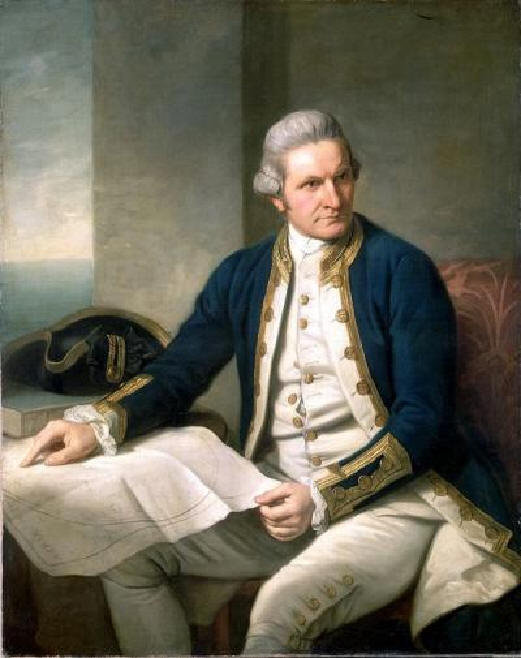
Captain James Cook, - possibly the
greatest of the marine navigators
So, when I was
privileged to travel throughout the south Pacific in the 1990’s for both
the United Nations Industrial Development Organisation, and the Asian
Development Bank, I took with me a copy of the journals of Cook’s
voyages. I also took with me Robert Louis Stevenson’s book “In the
South Seas”. The Scottish writer and poet ended his days in that
part of the world which he visited partly for health reasons. Cook’s
voyages took place in the mid-18th century, and Stevenson’s
in the later 19th century. My visits were in the late 20th
century, so I had a first-hand picture of the region, complemented by
the two historical accounts, one a hundred years before, and one over
two hundred years earlier. The similarities were surprising, and the
contrasts, fascinating.
An anecdote in passing
: I happened to be examining some of the relics of Captain Cook in the
navigation section of the Greenwich Maritime Museum in London, with my
younger brother who was in the metropolitan police at the time, when he
recognized another visitor there. It was Sir Francis Chichester, the
solo voyager who had sailed around the world alone in 1967 in his yacht,
Gypsy Moth IV. James went across to him and politely requested
if he could have an autograph which Chichester readily granted. But he
then made a remark that seemed to place himself on a par with James
Cook. Perhaps that impression was not intended, but that was how it
struck us. To me, Cook was head and shoulders above most navigators,
even the intrepid modern solo ones. Incidentally, Sir Francis was not
the world’s first solo round-the world sailor. Joshua Slocum of Boston
performed the feat around 1890 in his yacht, the Spray, though in
more leisurely fashion. I guess Chichester was the first to accomplish
the solo trip without stopping en route. But I should not detract from
his truly amazing voyage, or from those of other remarkably brave and
determined men and women solo sailors who have followed in his wake.
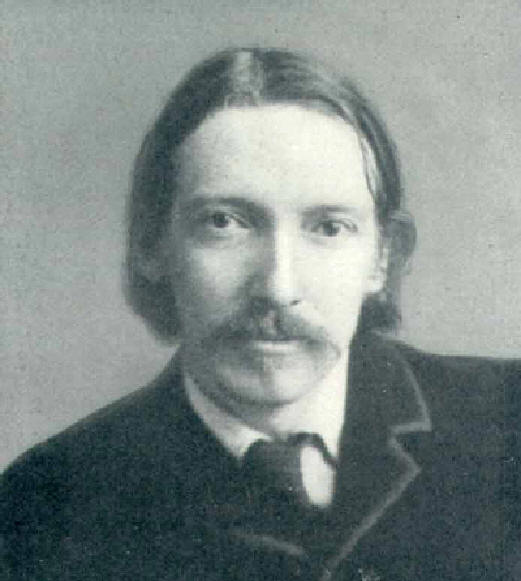
Robert Louis Stevenson
I was fortunate that my
work took me to most of the Pacific islands, - Guam, Yap, Micronesia,
the Marshalls, Kiribati, Fiji, the Solomons, Vanuatu, Tonga, the Cook
Islands, and West Samoa. One cannot help liking the Polynesian and
Melanesian peoples. I also enjoyed the range of Pacific foods and
fishes, including the now scarce but delicious coconut crab; - yes, - a
crab that eats coconuts ! If I had a disappointment in the Pacific, it
was that with the advent of western technologies, they have largely lost
their traditional boat-building and sailing skills. Instead of
beautiful sailing canoes longboats and schooners, the islanders have
gone for fiberglass runabouts and fuel-expensive outboard motors. There
are attempts to retain and resurrect the skills involved in the design,
construction and operation of the old outrigger boats, but they have
been limited in number and scope. Few of the islands now have a genuine
coastal fishery, apart from those who harvest the reefs with spear-guns
and drive-in gill nets.
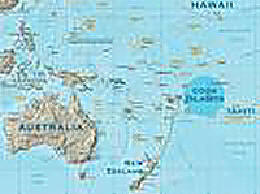
Map of the South Pacific
On several occasions I
visited Hawaii, and the larger west Pacific islands of Papua New Guinea
and the Philippines. Pacific islands are in two types; - the larger
volcanic islands, examples of which are Hawaii, the Solomons, and
Raratonga in the Cooks; and the atoll islands like the Marshalls,
Kiribati, (the former Gilbert and Ellis Islands), most of the Cooks, and
much of Micronesia. Majuro in the Marshalls where I spent more than a
year, was typical. The island was in a rough horse-shoe shape, 26 miles
long and from 50 to 300 yards wide. No part of the land was more than 3
metres above sea level. We used to joke of a bridge that joined two
parts, that if global warming caused the ocean to rise by just over two
metres, - there would be 10,000 persons on that bridge!
Papua New Guinea
Papua
New Guinea I was to visit four times. The first occasion was in 1981 on
behalf of IFAD the International Fund for Agriculture Development, which
was established to provide poor countries with investment to assist
small farmers, foresters and fishers. The next two assignments were in
the 1990’s for the Asian Development Bank, through a New Zealand
company, and the final one was on behalf of FAO. On these occasions I
was to visit the south-west and north-east coasts of the country, plus
many of the islands, from Milne Bay to the south, to New Ireland and New
Britain in what used to be called the Bismark Archipelago.
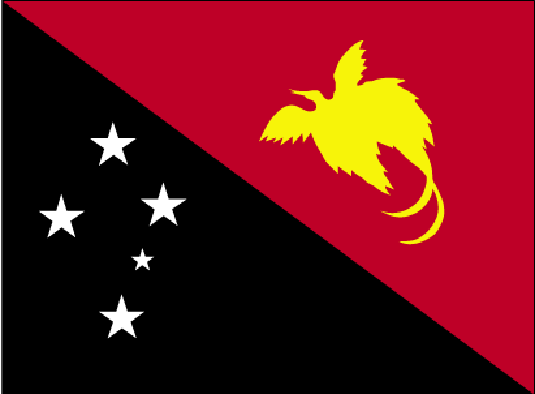
the flag of Papua New Guinea
PNG
people are friendly and hospitable like are most Pacific islanders.
They are also a proud and sometimes combative people. The government
unfortunately suffers from the lack of national unity. Most New
Guineans have a strong loyalty to their community and their clan, - what
are known there as their “wantoks” (one-talk’s). In contrast, their
loyalty to central government is quite weak. The impact of this
attitude affects society at all levels, and can compromise the
administration of justice and law and order at times. Many a time, when
a Prime Minister or Department Head, has tried to discipline an
offending MP or civil servant, he has had to back down in the face of
fierce and united protest by the man’s wantoks. In the long term, that
cultural propensity has prevented the beautiful and wealthy country from
achieving its full potential.
The
IFAD mission was led by Francois Bourgeois, a pleasant Frenchman who had
fought on the losing side in 3 wars, and had no wish to fight in any
others. (I believe they were the French military actions in the first
year of WW2, plus Vietnam, and Algeria.) We had a decent economist, but
were saddled with a credit specialist from the sub-continent who had a
bureaucrat’s obsession with petty rules, real ones and imagined ones.
When the fishermen declared their total disgust with the national
development bank which though it offered slightly lower rates than the
commercial banks, was absolutely hamstrung with red tape and paperwork,
- he insisted that the IFAD funds could not possibly be handled by any
other lending body. One progressive coastal village asked for a loan
for a fishing boat which the officer was ready to agree to, until they
mentioned that at harvest time, they would use the same vessel to
transport coconuts to market in Lae. “Absolutely not !”,
insisted this inflexible consultant, “this is a fishery loan, and if
you are going to use that boat for any other purpose, I will not approve
it”. Over the years I have lost count of the number of
occasions when I have despaired of such pig-headed development ‘experts’
! As I often suggest, more harm is done to the development process by
stupidity and incompetence than by corruption.
One of
the highlights of my first visit was a fresh encounter with one of the
finest of Britain’s fishery technologists. John Garner of Grimsby who
wrote some classic textbooks on nets and gear, was then teaching in the
PNG National Fishery college in Kavieng. I had devoured all of his
books and papers back in the 1960’s, and was instrumental in having him
address fishery conferences in Canada and the USA. Later we were to
obtain his assistance for the FAO fisheries publications programmes.
John was a true gentleman, with a Yorkshireman’s wry sense of humour.
He and his wife eventually retired to Portugal.
On the
subsequent assignments in PNG, I was to work with esteemed colleagues
who became long time friends. Our national counterparts were with few
exceptions, men and women of ability and commitment. One of the team
members was Sir Mekere Morauta former head of the central bank, who went
on to become Prime Minister a few years later. His Australian wife ran
a local fishing company with vision and efficiency. The Head of the
Fish Industry Association was a fine former fishery officer from UK,
Maurice Brownjohn OBE.
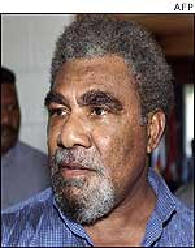
Sir Mekere Morauta, former Prime Minister
of PNG. I had the pleasure of working with him and his wife on fishery
development projects for that country, before he was overwhelmingly
elected to head the government.
PNG
then still had a huge store of wildlife, and many yet unspoiled coral
reefs and mangrove forests. At Madang on the northern coast, it was a
delight to breakfast in the garden of a pleasant hotel and watch the
tree kangaroos, monkeys, and parrots that lived there in semi-liberty.
One particularly aggressive toucan struck fear in the hearts of some
guests when it boldly attacked their papaya fruit at the table !
During my stay in the country there was one alarming volcanic eruption
at Rabaul on the eastern end of the island of New Britain, and an
escalation of conflict with the break-away province of Bougainville in
the northern part of the Solomons archipelago. The Rabaul eruption of
September 1994 came from 2 volcanic peaks, Tavurvur and Vulcan, which
showered the lovely coastal bay town of Rabaul in a blanket of white
ash, displacing 50,000 inhabitants. Fortunately casualties were only 5
deaths.
Port
Moresby is an attractive town, with a number of WW2 sites nearby, still
containing the remains of ships, planes or military vehicles from that
conflict. It can be dangerous place at night, and is not a place where
women can wander freely on their own. I knew missionary girls who were
respected and protected in the villages and communities where they
worked, but who would not travel unescorted to places where they were
not known, as that would invite unwelcome attention. Moresby also has
its bright side, with many good amenities, scenic places, churches,
schools and sports facilities. The PNG people have a love-hate
relationship with Australia which has tended to be paternalistic if not
overbearing in the way it treats its nearest foreign neighbour. The New
Guineans in return enjoy the benefit of Australian tourism and
investments by Australian business.
While in the Pacific I
met one of the descendants of the Bounty mutineers. Nig Kay Brown was
from Pitcairn Island where he acted as policeman, harbour master,
radio-telephone operator, postman, and customs officer, for the 50 plus
inhabitants. He gave us an interesting account of the people, their
culture, and their aspirations. The only income that island community
had was from sale of their postage stamps as collector’s items. They
had to pay $ 20,000 for a ship from New Zealand to California to stop en
route and drop off groceries and essential goods to a small local tender
boat. The cost of the goods was on top of the $ 20,000. Nig had been
sent abroad by the community to try to obtain or charter a refrigerated
steel long line vessel that would fish around the island and take the
catch to Tahiti for sale. At the same time it could carry any islanders
who needed medical attention or wanted to travel to New Zealand. As far
as I know he was unsuccessful in the quest.

Pitcairn Island where most of the
Bounty mutineers settled
Strangely, Nig did not
appreciate questions or comments about the Bounty mutiny. There was
almost a sense of embarrassment about that aspect of their past. I have
noticed similar reluctance towards unhappy past memories on the part of
indigenous peoples from Africa to the Hebrides. I was glad Nig was not
among those islanders charged with sexual offences in 2004 when some
cases of under-age sex came to the attention of the authorities in New
Zealand. Offences like that, while deplorable, are not unusual in a
small isolated community.
|
Captain Bligh
and the HMS Bounty
The story of
HMS Bounty is fascinating. Captain Bligh had been a junior
officer on James Cook’s ship. He was a determined man, a
competent seaman, and an expert navigator. But he had character
flaws, and was over-bearing and insufferable as a commander.
The Bounty mutiny was not the only one he provoked. 16 years
after the mutiny he was made Governor of New South Wales,
Britain’s colony in Australia. The colonists, no strangers to
strict regimes, found Bligh intolerable, and they revolted
against his rule after 3 years. Bligh was imprisoned and sent
back to England. But he had friends in high places and was
eventually promoted to Vice-Admiral.
However, Bligh’s
greatest achievement was the incredible 3,600 mile voyage in a
23 foot open sail-boat with 18 sailors. The journey took 7
weeks, from the vicinity of the island of Tonga, to the eventual
destination, the closest outpost of European civilization they
knew of, in the island of Timor in the centre of the Indonesian
archipelago. In some ways, Bligh’s undoubted courage and
determination, and his obstinate character flaws, resemble
another British expedition leader, Captain Robert Falcon Scott,
who succeeded in reaching the South Pole in 1911 but lost his
life and those of his men in the process, largely due to his
stubborn refusal to use sleigh dogs.
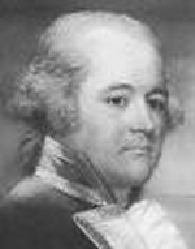
Captain William Bligh, former
mate to Capt. James Cook, who proved himself to be incapable of
leading and handling men, both on the Bounty, and later as a
Governor in New South Wales, Australia.
I am amazed at
how the British Navy reacted to the Bounty mutiny. The
Admiralty would not rest till it had hounded down all 25 of the
mutineers, and pursued them to the ends of the earth. Pitcairn,
that lonely rock, less than 2 square miles in size, in the vast
South Pacific was one such place, - one of the most isolated
places on earth. In today’s terms it would be like NASA sending
a spaceship to the back of the moon to locate a crew that had
mutinied on a spaceship ! Such was the Navy’s determination.
They captured ten of the mutineers on Tahiti and brought them
back to England where three of them were hanged. But those on
Pitcairn (including John Adams and Fletcher Christian) were not
discovered till 1825 when an amnesty was granted.
The mutineers
had salvaged a Bible from the Bounty before they set it on
fire. The Bible led to John Adams’ conversion and to his
personal transformation. The islanders adopted Seventh Day
Adventism as their denomination following the arrival of an
American missionary in 1886. |
For me, the most
beautiful and most pristine part of the Pacific was the Cook Islands.
This remote group of islands spread over thousands of miles of ocean, is
populated by handsome Polynesians who are related by language and
kinship to the Maoris of New Zealand, but who have no sympathy for the
negative aspects of Maori culture there where there is a high level of
unemployment, alcoholism and social misbehaviour. In contrast, the Cook
Islands communities are well organized, hard working, disciplined and
respectful to elders and traditions. One of the national practices is
to say grace at every meal. There are also prayers and thanks offered
by government officials before and after air flights and sea travel. I
have been in a restaurant in the Aitutaki atoll where the waiter,
assuming that we as foreigners did not know what was expected of us,
came across and respectfully said grace at our table. Perhaps one
reason Cook Islanders have avoided the failings of Maori culture, is
that they have been relatively isolated from western social influences
! Sometimes the interaction between cultures within a single country,
has a malign effect on the weaker and poorer or disadvantaged groups.
Examples of this would be seen in black ghettos and Indian reservations
in America, and in communities of Slavs in Germany or Austria, and Arabs
in the south of France.
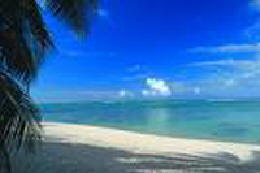
Cook Islands scene, - they are
among the most beautiful and pristine of all the South Pacific islands.
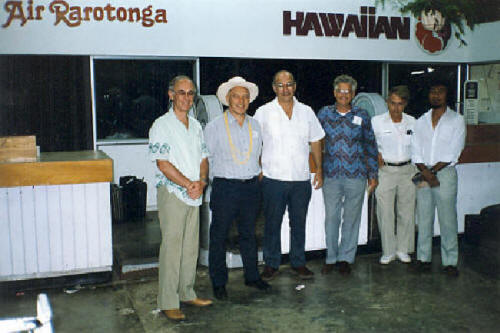
Myself with mission team in Rarotonga
The Island communities
are as attractive as the people. You can drive around Rarotonga or any
of the atolls, and you will see no litter or rubbish. Roads, gardens
and beaches are well maintained and free of pollution. The crystal
waters and corals of the coastal areas have no plastic bags, oil slicks
or debris. The whole country is a picture of what most people imagine
when they think of the south Pacific. As in most small Pacific states,
the resources are scattered and industries are small scale. The islands
have albacore tuna and there are black pearl oysters in the north. Reef
fish abound, and there is ample fruit grown to supply the tourist trade
and some niche export markets. Banana, pawpaw, coconut, pineapple,
orange and breadfruit are grown. As in other parts of the Pacific there
are taro tubers and sweet potato. An inspiring experience for me in the
Cooks, was to stand on the beach at Raratonga, any hour of the day or
night, and listed to the roar of the ocean seas pounding the reef
offshore. The Victoria Falls in Africa was called “the smoke that
thunders” by local natives in Livingstone’s time. The roar of the surf
striking the reefs at Rarotonga is even louder.
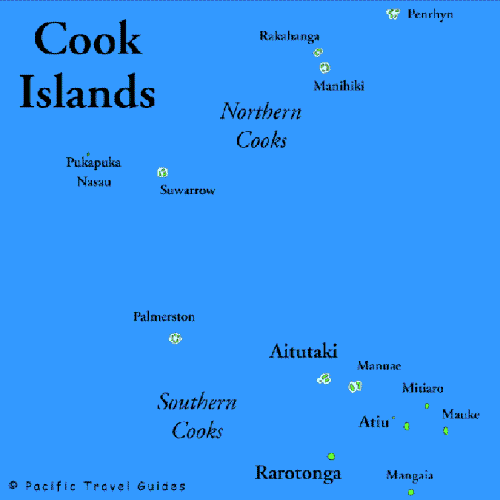
Map of the Cook Islands
One of my best Pacific
friends was a Cook-islander. Tom Marsters was a tall handsome
Polynesian who had played rugby as a student, and later excelled in
golf. He was one of a class of fishery officers I taught in Grimsby one
year. (He was later to give his son the name “Cleethorpes” in honour of
the Lincolnshire port). When I arrived in Rarotonga, Tom and Tuene his
wife were at the airport to meet me, and garland me with flowers in a
typical Pacific welcome.
Another friend from
Pacific days was Simon Waters, a remarkable young New Zealand fishing
skipper who had excelled at that profession. Working a relatively small
line-fishing boat for hoki and snapper, and other species, he landed
large amounts of fish the year before quotas were introduced in New
Zealand’s fishery. As a result he was awarded a big quota for the years
to come. Two years later he sold most of the quota for NZ$ 2 million,
effectively making himself a millionaire at around 29 years of age. But
he had no wish to settle down and enjoy the money. Instead he took his
latest vessel around the Pacific, and sought to assist small island
fishers to improve their operations and catches. This he did very
successfully in Vanuatu, teaching them to catch deep water fish by
long-line. The long-lines were cleverly rigged so their hooks hung just
above the sea-bed, otherwise the line would snag and be lost on the
rough rocks and corals. His boat, the “Pandora”, was as
beautiful a fishing vessel as I have ever seen. More like a motor yacht
than a fishing boat, it was varnished, had an auxiliary sail, and was
powered by a Gardner engine. Later, Simon was to fish a stern trawler
off Australia’s rugged north-west coast.
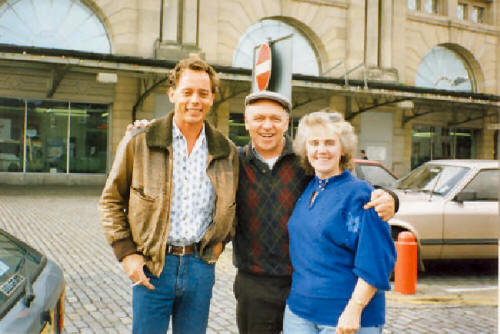
Simon Waters, intrepid young New Zealand
fisherman,
with myself and my wife when he visited us in Scotland.
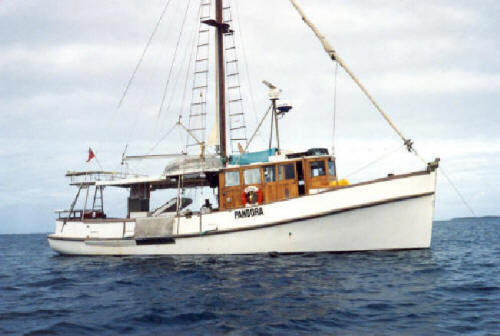
Simon’s beautiful fishing vessel, the
Pandora, which he fished from
New Zealand to the South Pacific islands.
The modern Pacific
states are at a crucial cross-roads in their history. They were the
focus of attention by the USA, Japan, and Australia / New Zealand,
during the war years, and some of them suffered considerably in
consequence. Apart from the fighting that took place on many islands,
there were the tests of nuclear weapons that contaminated some atolls
for a generation and more. The American military exploded 66 nuclear
bombs and missiles in the Marshall Islands, - 43 at Eniwetok and 23 at
Bikini. In the Gilbert and Ellis Islands (now the state of Kiribati),
24 were detonated in the vicinity of Christmas Island. Johnson Island,
a U.S. possession west of Hawaii saw the test of 12 nuclear weapons,
and, some say, though I have not seen it corroborated, production of
germ warfare material. The French also undertook a number of nuclear
tests in the Pacific, off Tahiti and other French territories. They
said these posed no threat to the people or the environment, but of
course, they would not have dared to test them in the Bay of Biscay.
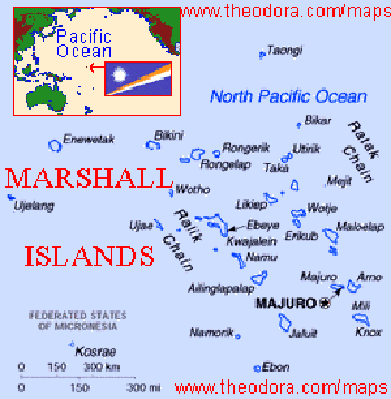
Map of the Marshall islands

Explosion of
an atom bomb Majuro airport, - a landing strip
on Bikini in the
Marshalls on a beach in the ocean
I spent 15 months in
the Marshall Islands, and so had opportunity to assess the effects of
the atomic tests there. It was many years before the people of Bikini
or Eniwetok could return to their island home, or eat the fish and fruit
there. The islands had so little prospect of a contamination-free
future, some politicians even spoke of making the best of a bad
situation by permitting the dumping of waste on the radio-active
atolls. Fortunately wiser minds prevailed, and to date that has not
happened.
Pacific islands and
their coral reefs are a most fragile environment, and any thought of
making them radio-active for generations, is downright criminal. It is
hard to believe, but there are agents for those seeking to dispose of
the colossal amounts of sludge and contaminated waste generated by
American industry and American cities, who ply the Pacific offering
millions of dollars to any who can persuade a small island country to
accept the stuff ! This is not hearsay. I have met those agents, and
have been offered such sums more than once, if I would use my position
to persuade a naïve government to let their small pristine territories
become a dumping ground.
A peculiarity of the
small Pacific states was that nearly all of them had some foreign
consultants advising the government. They were rather seedy characters
on the whole, - ex-CIA officers, beach combers, or opportunists. Mostly
they acted like go-betweens with foreign businessmen, and set up aspects
of deals that the Government Ministers did not want to be seen to be
involved in. Sometimes their influence had nasty results as in the case
of an Australian businessman I became friends with while in the Marshall
Islands. Greg Simmonds was then under virtual house arrest for
suspected fraud. He had been asked by the government to seek investment
in the country from businessmen in Taiwan and elsewhere. One of the
inducements the government could offer was the possibility of a
Marshallese passport, which effectively gave the holder long term access
to the USA.
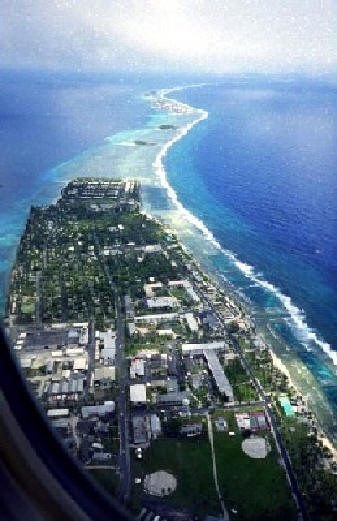
Majuro town, Marshall Islands capital
A number of businessmen
expressed interest, and they indicated that investments in new local
hotels and tourist resorts could mount to several million dollars. At
that point other sharks got interested, and those foreign advisers to
the government asked Simmonds to allow Larry Mahau of Honolulu to become
manager of the project. Well, Mahau was the reputed head of the
Hawaiian mafia (and had been a long-term business contact in Hawaii of
President Marcos of the Philippines), so Greg said in effect, “no
way”!. When he refused to budge on the point after prolonged
negotiations, he received a message dropping the condition, and asking
him to come to Majuro to sign the project contract. On arrival at the
airport his passport was taken from him, and next day he was charged
with seven counts of fraud. This was all in an apparent attempt to put
further pressure on him so he would hand the project over the parties
named.
Things went from bad to
worse when a distant relative of Simmonds, Senator Graham Richardson,
Prime Minister Keating’s senior supporter, telephoned President Kabau
and asked what was happening. Apart from the Senator and the President,
the only two others who knew of the call were Simmonds and his
assistant. Within two days, Australian tabloid papers were running
headlines like – “Australian Senator interferes in multi-million
dollar fraud case in the Marshall Islands”. Only later did Greg
discover that his loyal assistant was working with those seeking to take
over the project, and that the man’s girl friend worked in the office of
the then opposition Liberal party in Australia.
That the government
itself was not fully involved in the actions I can confirm since
President Kabau often came to his daughter’s hotel where I was staying,
and when Greg and I were dining would come over and sympathise with
Greg, and say he would try to find a way out of the mess. It was to
take over a year, but those ‘advisers’ who concocted the charges were
eventually dismissed, and Simmonds was allowed home after pleading
guilty to a technicality to save the government’s face. But in that
period he had been vilified in the Australian press, and his family had
suffered dreadfully. My own conclusion which I mentioned to Greg
several times was that he was an innocent victim, but also that he had
contributed to the situation by being over-trusting with certain
persons, and by being rather cavalier in his business style when a
degree of prudent caution could have protected him.
A footnote to the story
is that Mahau eventually became involved in a Marshallese project, this
one being for tuna long line fishing for the lucrative Japanese sashimi
market. His son was sent over to run the business, but died shortly
after it got under way. The tuna fleet was composed of a few
Marshallese vessels, and a larger number of mostly Taiwanese boats.
Some of the captains and engineers on the vessels were not well
qualified, and some of the boats were barely seaworthy. One boat went
missing while I was there. We began to think it had been lost, but
after several months it was located at Christmas Island. The engine had
broken down and with no electrical power the radio could not be used.
The crewmen had no food for several weeks, and were fortunate to
survive. But one crew member was missing, - a fact for which none of
the survivors could provide a reasonable explanation.
The ocean swimming
tunas are the most plentiful fish in the Pacific. Yellowfin tuna,
albacore and skipjack are the ones mostly used in canning. They are
caught by pole and line, or by purse seine, - the latter method being
much controlled now as dolphins were often captured in the nets as they
tended to swim near schools of yellowfin. Bluefin tuna are the most
expensive, and are highly prized in Japan where the flesh is eaten raw
as sashimi. The fish must be very fresh and of excellent
quality, but if so, they can command market prices per kilo, higher than
quality shrimp. Fleets of medium sized long liners fish for the bluefin
all over the Pacific. The fish are packed in dry ice and flown to Tokyo
for sale in the immense Japanese market.
Apart from tuna, the Pacific has an abundance of reef fish,
and of mollusks ranging from conical trochus valued for their
shells, to oysters, to giant clams. Other edible creatures include sea
urchins and beche de mer, a kind of sea slug that when boiled and
dried, is a valued commodity in Chinese markets. Sadly, the destruction
of coral reefs is reducing the habitat for many of these fascinating
forms of marine life. Below : Three of the many wonderful marine
creatures of the Pacific:
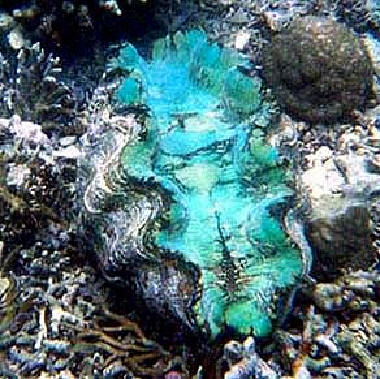
A giant clam, - this beautiful but
vulnerable mollusc does not deserve its
Hollywood film reputation for trapping people.
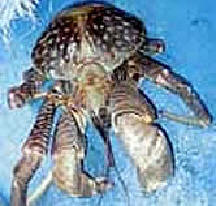
A coconut crab, - this fascinating
creature, born in the sea, lives mostly on coconut meat.
They are excellent eating, but are presently over-harvested.
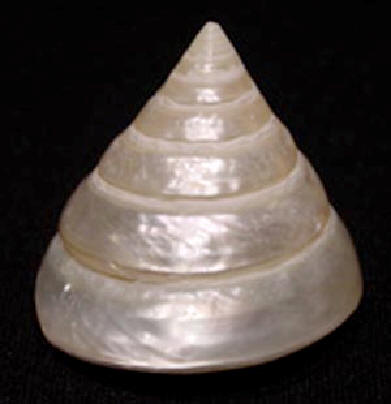
A trochus shell. This much valued
species is a major source of shell buttons and shell jewellery
The Island of Tonga had
its own unique culture. Its people were prone to obesity, the king
being a leading example of heaviness. He wielded almost total control,
like a benevolent dictator, through a semblance of democracy. There
were 14 seats in the parliament, 7 for commoners, and 7 for the local
nobility. But the king had the casting vote, and what the king decreed
was not challenged by the elected representatives. The people were
friendly as Captain Cook had noted, though somewhat sensitive, and one
had to exercise care to avoid hurt or misunderstanding. Sunday on Tonga
resembled the western isles of Scotland in some ways. Church attendance
was expected of the people who had to dress appropriately and largely
abstain from work and irreverent activities.
Moral codes are strong
in the Pacific (which may surprise casual observers), but they owe their
origins to traditional rules rather than to the influence of Christian
missionaries. Most Pacific societies live by taboo structures which
were established centuries before explorers first encountered Polynesian
peoples. Modern missionaries are disappointed when Pacific converts or
applicants ask them “what are the taboos?” Religion for many is
seen only in that light. James Michener described how it all began :
“The
days of the moon, the turning of the season and the planting of crops
were all placed under tabu. So were laughing at improper moments,
certain sex habits, the eating of certain fish and the ridicule of
either gods or nobles. Tabu was the temple, tabu were the rock gods,
tabu was the growing coconut tree. At some seasons, even the ocean
itself was tabu, on pain of death.
In this
manner, and with the approval of the people, who wanted to be organized
within established levels, the tabus were promulgated and patterns were
developed whereby each man would know his level and none would
transgress. What had been a free volcanic island, explosive with force,
now became a rigidly determined island, and all men liked it better, for
the unknown was made known.” [From
the sun-swept lagoon,
in Hawaii, James A.
Michener, Ballantine Books, Random House, New York, 1959.]
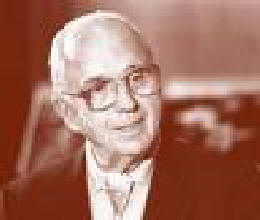
James A. Michener
Michener’s description
of the Polynesian moral codes, sets the background to the arrival of
traders and missionaries in the Pacific. Some, like explorer James Cook
and missionaries John Williams (1796 – 1839), and James Chalmers (1841 –
1901), were men of integrity and of sincere concern and respect for the
native peoples and their culture. Others were more inclined to exploit
and to impose foreign cultures in the name of Christ. A sad and
poignant illustration of what happened in much of the Pacific is evident
in the experience of Hawaii in the later 19th century. That
lovely group of scenic islands, which were first populated by Polynesian
sailors, was cruelly afflicted by foreign diseases, and had oriental
labour brought in to augment the diminished local population on sugar
farms.
The sons of missionaries joined with American sugar The sons
of missionaries joined with American sugar merchants to develop a ruling
class that manipulated Hawaian government measures to boost their power
and profits. They displaced the traditional Polynesian structures, and
forced the King at bayonet point, to accept a Constitution that deprived
natives of the vote, and took effective power away from the monarch. On
the King’s death he was succeeded by his sister, Queen Liliuokalani, a
woman of sterling character whose one weakness was her unwillingness to
shed blood in defence of her country and her people. The sugar barons
had few such scruples. They had her overthrown illegally, and even
when President Calvin Coolidge’s emissary James Blount, found in favour
of the Queen, they managed to petition Congress to reverse the
decision. Queen Liliuokalani could have had the guilty men arrested and
incarcerated. Instead she pardoned them. Their thanks was to arrest
her the year after Congress put them back in power in 1894, and have her
sentenced to years of hard labour. That was how the sons of
missionaries behaved. Fortunately, the sentence was not carried out in
full, though the injured Queen was kept in virtual confinement for 12
months. She died at the age of 79 in 1917.
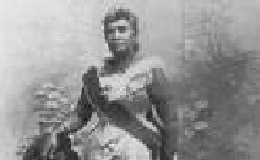
Queen Liliuokalani of Hawaii, a woman of
great integrity, who was deposed and imprisoned by a bunch of ruthless
American businessmen on the islands (with apparent help and
encouragement from some in the U.S. government).
I mention this sad
episode to expose the un-christian behaviour of some who professed to
follow Christ. I readily defend the work and character of Christian
missionaries. The vast majority I have known have sacrificed lives and
lifetimes to serve others. They mostly received little recognition and
little monetary support. But there have been some who did otherwise.
And if the best of them behaved circumspectly, sometimes their offspring
acted in grossly exploitative ways. This happened in Hawaii, in South
Africa, and in much of South America. An astonishing thing we see in
all three regions, is how the local population came to faith in Christ,
and still cling to that faith, despite the despicable behaviour of some
of the descendants of those that first brought that message to their
forefathers. “The name of God is blasphemed among the gentiles
because of you” said Jesus to the hypocritical Pharisees. And so it
has been with some who used religion as a cloak for their greed, in the
Christian era. The Scots poet, Burns wrote, “All hail Religion, maid
divine, pardon a muse so mean as mine, who … daurs to name Thee. To
stigmatise false friends of Thine can ne’er defame Thee”.
[From
the poem to the Rev John M’Math , by Robert Burns.]
Some humanists accuse
all missionaries of the vilest of motives and actions, but in my
experience, such meanness and hypocrisy is found in very few.
Throughout Africa and Asia I have seen scores of hospitals and
orphanages and schools and leper colonies and aids hospices financed and
run by Christians. I have yet to find a single one financed and
operated by humanists or Marxists.
Robert Louis Stevenson
who lived through the period of Hawaii’s troubles during his last years
in the Pacific, foresaw the destruction of Polynesian culture and the
corruption of Polynesian society. He viewed with increasing gloom the
growing trend for the traditional Pacific societies to be overwhelmed by
western cultures and commercialism.
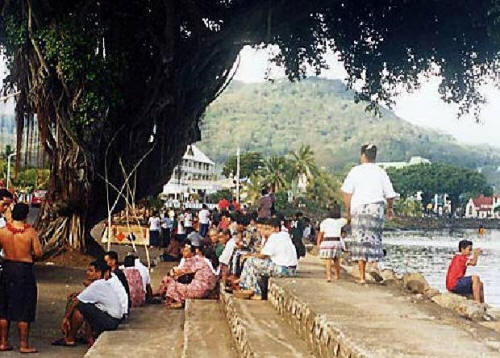
Apia, the capital of West Samoa
Tourists wishing to see
their ‘Hollywood’ caricature of the Pacific should stop over at West
Samoa where the film South Pacific was located, and the Michener
story on which it was based. The most famous hotel in the little
capital of Apia is Aggie Grey’s where many of the rich and famous have
stayed. Their names now decorate the individual rooms. The original
Aggie Grey was reputed to have been Michener’s model for “Bloody
Mary”, in the book and the film, but I believe he said that she was
just a composite representative character. Certainly Aggie Grey made
her money off the American fleet, but she was a beautiful and cultured
woman, and not the rather mercenary amoral type seen in the film. She
had passed away by the time I visited Samoa, but her equally beautiful
granddaughter was managing the hotel to which she gave her name.
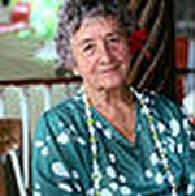
Aggie Grey of Apia, West Samoa
Robert Louis Stevenson
was one of the guests at the wedding of Aggie Grey’s parents around
1894. And that brings us to West Samoa’s most famous resident.
Stevenson ended his days there after sailing around the Pacific in the
chartered yacht “Casco”. His house Valima, located a few
miles behind Apia, is now a tourist visitor attraction.
Louis was known to the
Samoans as “Tusitala” – teller of tales, and today that
appropriate title is commemorated in the name of another hotel in Apia.
RLS was fittingly buried at the top of the steep little Mount Vaea. His
grave is open to the sea and the sky, and surrounded by rhododendrons
and flowering shrubs. From that vantage point there is a magnificent
view of the ocean, the island coast, and the mountains behind. I was
moved by the sight, and touched afresh by his own obituary, that is
inscribed on the side of the grave:
Under the
wide and starry sky,
Dig me the grave and let me lie;
Gladly I live, and gladly die,
So lay me down with a will.
This be the verse that you grave for
me;
Here he lies where he longs to be;
Home is the sailor, home from the
sea,
And the hunter home from the hill.
|

